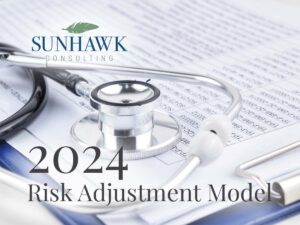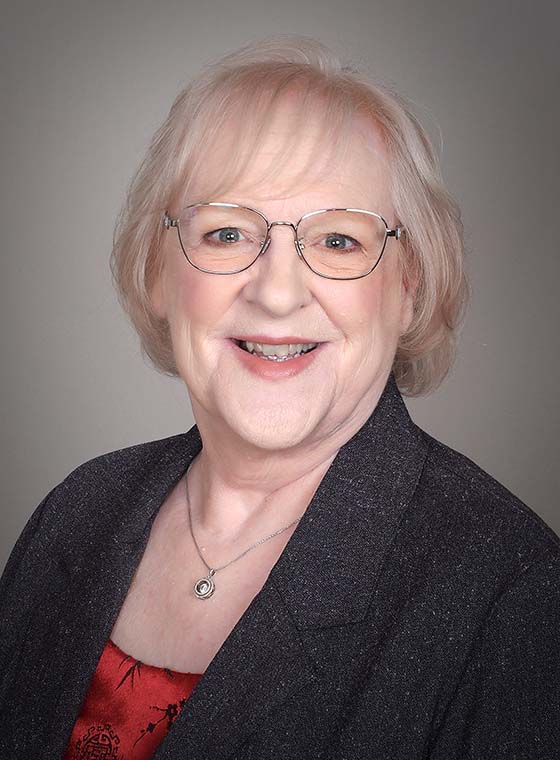
This article, as part of the SunHawk Consulting team’s Medical Risk Adjustment compliance as well as statistical sampling & coding audit services, gives a high level overview of some upcoming changes for 2024 in the CMS Risk Adjustment model, V28.
The CMS-HCC Risk Adjustment model for payment year 2024 has many changes. The number of Hierarchical Condition Categories (HCCs) is going from 86 to 115. The total number of ICD-10-CM codes that map to one of those categories is decreasing from over 9,700 down to only 7,770 and some of the codes no longer mapping to an HCC category are “common” conditions such as I73.9 for peripheral vascular disease, unspecified.
The coefficients used for calculating the Risk Adjustment Factor (RAF) for the HCCs are also changing. For example, even though there will be 4 separate categories related to diabetes, the coefficient for each category is the same. To compensate for the loss of the hierarchy related to the coefficients, the rate for the base coefficient for diabetes was raised.
Recommendations:
Because so many codes have been deleted and no longer map to an HCC category, SunHawk recommends you analyze the diagnosis codes you have previously reported under the Risk Adjustment program. Determine diagnoses that were reported with high volumes to ensure the diagnosis codes still map to an HCC category. If so, determine if the grouping and/or hierarchy changed. If the codes no longer map to an HCC category, determine if provider education for clinical documentation improvement may increase the likelihood the providers will document enough to support a more specific code that does map to a category.
For example, I73.9, peripheral vascular disease, unspecified, no longer maps to an HCC category. This is a condition that is often noted in the Medicare population. With improved assessment and documentation, it may be possible to have the providers document and support codes for atherosclerosis of the extremities. But that one change in documentation is not enough. Under Version 28, atherosclerosis of the extremities must be accompanied by ulceration, gangrene, or rest pain to qualify for risk adjustment. Also realize that those additional conditions are not necessarily chronic & long-lasting. So, if the ulceration, gangrene or rest pain resolves, the codes should be changed to the most appropriate code for the diagnosis at the time of the visit.
Another example is that there are multiple behavioral health diagnoses that no longer map to an HCC category. Assessment and documentation of the type of disorder, severity of disorder and current status of the disorder must be documented to support the more specific codes that do map to any HCC.
SunHawk has clinical and coding experts who can help you with the data analysis, record review, and education for your providers and coders, etc. Attempting to address HCC matters with just a coding perspective may miss the clinical understanding needed to fully address the changes in the HCC categories.
Brief Summary of Changes:
Infectious Disease Group:
No changes.
Neoplasm Disease Group:
Increased to 7 separate levels from 5; Numbering is changed (now 17, 18, 19, 20, 21, 22, and 23); Category names have changed; 25 new diagnoses added.
Diabetes Disease Group:
Increased to 4 separate levels from 3; Numbering is changed (now 35, 36, 37, and 38); Category names have changed; Added category for pancreatic transplant status; Removed all E09.- – codes (drug or chemical induced diabetes).
Metabolic Disease Group:
Increased to 4 HCC levels from 3; Numbering is changed (now 48, 49, 50, and 51); Naming changed; 4 new diagnoses added; (Protein-calorie malnutrition diagnosis codes removed)
Liver Disease Group:
Increased to 5 HCC levels from 3; Numbering is changed (now 62, 63, 64, 65, and 68); Naming changed; 12 new diagnoses added.
Gastrointestinal Disease Group:
Increased to 5 HCC levels from 3; Numbering is changed (now 77, 78, 79, 80, and 81); Naming changed; 20 new diagnoses added (perinatal and congenital conditions).
Musculoskeletal Disease Group:
Increased to 3 HCC levels from 2; Numbering is changed (now 92, 93, and 94); Naming changed; 4 new diagnoses added.
Blood Disease Group:
Increased to 7 HCC levels from 3; Numbering is changed (now 107, 108, 109, 111, 112, 114, and 115); Naming changed; 8 new diagnoses added (7 which are perinatal); 79 diagnoses removed (e.g., D84.- for immunodeficiency codes, D69.- for thrombocytopenia codes, D68.69 for other thrombophilia, etc.)
Cognitive Disease Group:
Increased to 3 HCC levels from 2; Numbering is changed (now 125, 126, and 127); Naming changed; Dementia now categorized by severe, moderate, or mild/unspecified; 20 diagnoses removed.
Substance Use Disorder Disease Group:
Increased to 5 HCC levels from 3; Numbering is changed (now 135, 136, 137, 138, and 139); Naming changed; 20 diagnoses removed; 26 new diagnoses added (perinatal conditions).
Psychiatric Disease Group:
Increased to 5 HCC levels from 4; Numbering is changed (now 151, 152, 153, 154, and 155); Naming changed; 4 new diagnoses (anorexia nervosa & bulimia); 425 diagnoses removed (including manic & bipolar disorder in full remission, major depressive disorder single (mild and partial or full remission), recurrent, mild or partial or full remission, unspecified mood disorder, and many T codes for suicide attempt, poisoning or toxic effects, etc.)
Spinal Disease Group:
Numbering is changed (now 180, 181, and 182); 90 diagnoses removed; 2 new diagnoses added (one of which is perinatal).
Neurological Disease Group:
Increased to 12 HCC levels from 8; Numbering is changed (now 190, 191, 192, 193, 195, 196, 197, 198, 199, 200, 201 and 202); Naming changed; 18 new diagnoses added (perinatal conditions); Some diagnoses from the old spinal disease group HCC 72 now under these HCCs which will affect hierarchy, etc.; 48 diagnoses removed (including Neuroleptic-induced parkinsonism – G21.11; SEVERAL polyneuropathy codes – G61.1, G61.89, G61.9, G62.0, G62.1, G62.2, G62.81, G63; Several M codes for rheumatoid polyneuropathy conditions; and the R40.— codes for coma scale).
Arrest Disease Group:
Still 3 HCC categories; Naming now includes “respiratory and tracheostomy complications”; Numbering changed (now 211, 212 and 213); 16 new diagnoses added (perinatal conditions); Ventilator-associated pneumonia, J95.851, now under this category; 6 diagnoses removed (including some pulmonary insufficiency codes, post-procedural respiratory failure and post-procedural cardiogenic shock).
Heart Disease Group:
Increased to 10 HCC levels from 5; Numbering is changed (now 221, 222, 223*, 224, 225, 226, 227, 228, 229 and 238); Naming changed; 5 new diagnoses added (one perinatal condition and 4 T codes for artificial heart complications); Some diagnoses from the old HCC 186 related to heart transplants are now under these HCCs which will affect hierarchy, etc.; 38 diagnoses removed (including many angina codes – I20.9, I25.118, and I25.119, etc.). Please note: HCC 223, Heart Assist Device/Artificial Heart, will only be reimbursed if the beneficiary is also reported with at least one diagnosis from the heart failure HCCs of 224, 225, or 226.
Cerebrovascular Disease Group:
Still 4 HCC levels; Numbering is changed (now 248, 249, 253, and 254); 4 diagnoses removed (infarction during surgery codes); 20 new diagnoses added (perinatal conditions).
Vascular Disease Group:
Still 3 HCC levels; Numbering is changed (now 263, 264, and 267); Naming changed; 183 diagnoses from the old HCC 107 and 108 categories were removed (including PVD – I73.9, several codes for atherosclerosis of the extremity diagnoses, several codes for aneurysms without rupture, atherosclerosis of the aorta, and other such codes); Codes from I26.0- moved from the old HCC 85 CHF group to this group; 2 T codes for traumatic air or fat embolism were moved to this group.
Lung Disease Group:
Increased to 7 HCC levels from 5; Numbering is changed (now 276, 277, 278, 279, 280, 282 and 283); Naming changed; 10 new diagnoses added; 2 codes for lung involvement from polyarteritis and Sjogren syndrome are moved to this group; 7 codes related to lung transplant are moved to this group; 42 diagnoses removed (including J18.1 for lobar pneumonia, I70.2 through I70.9 for interstitial lung disorders).
Eye Disease Group:
Still 2 HCC levels; Numbering is changed (now 298 and 300); Naming changed; 24 diagnoses related to drug or chemical-induced diabetes (E09 range) were removed; 76 new diagnoses added (including some non-proliferative diabetic retinopathy codes).
Kidney Disease Group:
Decreased to 4 HCC levels from 5; Numbering is changed (now 326, 327, 328 and 329); Naming changed – separate categories for 3B versus 3A or unspecified stage 3; Only 9 codes map to this group; 55 diagnosis codes were removed (including All codes from old HCC 134 (dialysis status)).
Skin Disease Group:
Increased to 7 HCC levels from 5; Numbering is changed (now 379, 380, 381, 382, 383, 385, and 387); Naming changed; 14 new codes added; 8 diagnosis codes removed (including Stevens-Johnson syndrome – L51.1 and Lyell syndrome – L51.2).
Injury Disease Group:
Increased to 6 HCC levels from 5; Numbering is changed (now 397, 398, 399, 401, 402 and 405); Naming changed; 285 diagnoses removed (mostly sequela codes from HCC 167 and T codes from HCC 173); 1 new diagnosis added (perinatal condition).
Complications Disease Group:
Removed group altogether; All 325 codes removed (some codes moved to different HCC categories).
Amputation Disease Group:
Still 1 HCC level; Numbering is changed (now 409); 3 new diagnoses added; 250 diagnosis codes removed (including the S89.94– codes for acquired absence of left and right great toes, other toes, and unspecified side).
Transplant Disease Group:
Still 1 HCC level; Numbering changed (now 454); Naming changed to Stem cell, Including Bone Marrow, Transplant Status/Complications; Codes related to D89.81- for graft-versus-host disease now under this group.
Openings Disease Group:
Still 1 HCC level; Numbering is changed (now 463); No changes to mapped codes.
Summary:
There are multiple changes coming. Be aware of what they are; how they may affect you; if and how you can mitigate them; and steps you need to initiate to monitor for proper diagnosis, proper and thorough documentation and proper and accurate coding and reporting. Please reach out to SunHawk Consulting for assistance with Medical Risk Adjustment compliance as well as statistical sampling & coding audit services or other areas for which we may be of assistance.

Lorraine Aniello
Clinical Coding Audit Director
SunHawk Consulting, LLC
[email protected]
Lorraine is a Registered Nurse and holds certification as a Certified Professional Coder (CPC), Certified Risk Adjustment Coder (CRC) from the American Academy of Professional Coders (AAPC), and Advanced HCC Auditor (AHCCA) from Rise Health. She is also certified as a HealthCare Anti-Fraud Associate (HCAFA).
Lorraine has been a coding trainer and reviewer for one of the largest U.S. healthcare organizations. Within regulatory organizations, she has worked with state Medicaid policy and program integrity, MFCUs, RACs, MEDIC, and was a corporate clinical trainer for a national vendor who assisted Medicare and Medicaid Advantage companies with risk adjustment data collection, coding and reporting. She has provided testimony and expert analysis for both government prosecutors, litigation counsel, and defense counsel.

Rachael Mills
Managing Consultant
SunHawk Consulting, LLC
[email protected]
Rachael Mills is a Managing Consultant with SunHawk Consulting, LLC and is experienced in medical claims analytics, statistical analysis, compliance assessments, GRC (governance, risk and compliance) platform configuration and overall project and program management. She is skilled in compliance program communication development including digital design, brand management, training development, and marketing communications. At a national healthcare credentialing organization Ms. Mills assisted with the design and implementation of both internal and external forms of marketing communications and collateral. At SunHawk, she has supported numerous compliance reviews, HIPAA assessments, statistical engagements, investigations, and GRC tool implementations. Ms. Mills has assisted with annual compliance risk assessments conducted for clients as part of their Corporate Integrity Agreement (CIA) with the Office of Inspector General (OIG), as well as supported SunHawk during Independent Review Organization (IRO) engagements.
SunHawk experts are highly experienced professionals ready to assist you within our focus areas of:
Healthcare Compliance | Corporate Investigations
Corporate Compliance | Litigation Disputes
Have a question? We are ready to answer it.
